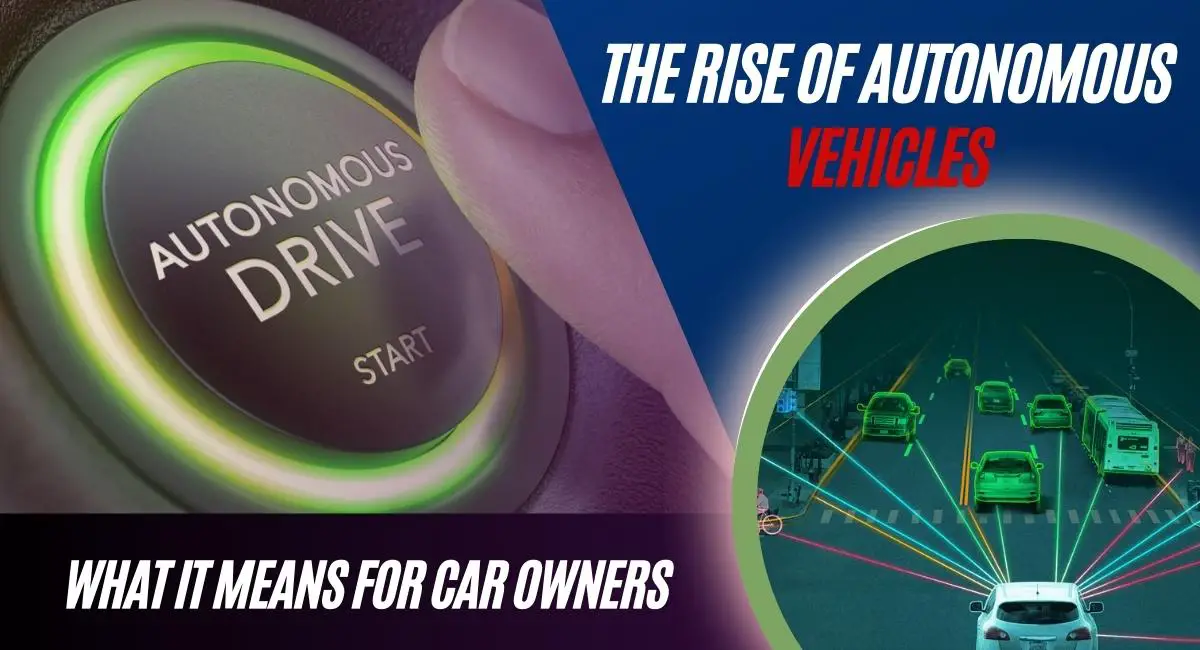Imagine you’re behind the wheel, but instead of navigating through the hustle of traffic, you’re kicking back, catching up on emails, or diving into a good book. It sounds like something out of a sci-fi movie.
Well, guess what? This futuristic daydream might be plausible thanks to the rise of autonomous vehicles. Autonomous vehicles are like the superheroes of transportation – gearing up to revolutionize the way we get from point A to point B.
They’re not just about self-driving cars; they’re about making our roads safer, easing traffic jams, giving everyone a shot at mobility, and shaking up the automotive scene. Since they have a pack of fancy tech like sensors and artificial intelligence, these vehicles aren’t just changing the game but rewriting the rules.
So, let’s look into:
- features of autonomous cars,
- explore their advantages to car owners,
- discuss the challenges and concerns surrounding their integration,
- analyze the impact on the automotive industry,
- examine the current regulatory landscape, and
- speculate on the future outlook.
Key Features of Autonomous Vehicles
To understand the impact of autonomous vehicles, let’s first unravel the technology behind them. Autonomous vehicles come in different levels, classified by the Society of Automotive Engineers (SAE).
At the lowest levels, drivers maintain control, while at the highest levels, the vehicle operates entirely without human intervention. These levels represent a spectrum of automation, from essential driver assistance features like cruise control to fully autonomous driving.
Advanced sensor technologies, including radar, lidar, and cameras, form the foundation of autonomous vehicles. These sensors enable the vehicle to perceive its environment, identify obstacles, and make informed decisions.
Artificial intelligence and machine learning algorithms process this information, learning from real-world scenarios and improving the car’s ability to navigate diverse and dynamic road conditions.

How Do Autonomous Cars Work?
As mentioned, autonomous vehicles operate through a combination of sophisticated technologies. It includes sensors, actuators, advanced algorithms, and high-performance processors. Integrating these components forms the foundation for the functioning of self-driving cars, elevating them to technological sophistication that surpasses conventional computing capabilities.
First up, they’re like little cartographers on wheels. These cars create and update maps of their surroundings using various scattered sensors. Radar sensors keep tabs on nearby cars, video cameras are on the lookout for traffic lights and pedestrians, and there’s even this thing called Lidar – it shoots out pulses of light to measure distances and determine where the road ends and begins.
And here’s the kicker – ultrasonic sensors in the wheels are like little detectives sniffing out curbs and other cars when you’re trying to squeeze into a parking spot.
Now, let’s talk brains. All this sensor info gets thrown into a high-tech blender. The software, which is practically a genius, takes this sensory buffet, cooks up a plan, and sends orders to the car’s actuators – those are the guys in charge of acceleration, braking, and steering.
But wait, there’s more. The software isn’t just winging it; it’s got a bag of tricks. Think hard-coded rules, obstacle avoidance algorithms, and predictive modeling – it’s like the car’s sixth sense, helping it follow traffic rules, dodge obstacles, and be an all-around superstar on the road. And there you have it – the not-so-secret recipe for how these autonomous marvels do their thing.
Advantages for Car Owners
The transition to autonomous vehicles brings a host of advantages for car owners. Let’s explore the exciting advantages that autonomous vehicles hold for car owners in this era of technological revolution.
Safety Improvement
- Drastically reduces accidents and fatalities by eliminating human errors.
- Sensors continually monitor the surroundings, and AI makes split-second decisions, significantly diminishing the risk of collisions.
Increased Convenience
- Autonomous parking allows cars to find parking spots in crowded areas.
- Commuting becomes hands-free, enabling occupants to utilize travel time productively.
- Enhances the overall convenience of daily activities, transforming the driving experience into a more relaxed and enjoyable one.
Time and Cost Savings
- Predictive analytics in connected and intelligent vehicles anticipate maintenance needs, reducing the likelihood of unexpected breakdowns.
- It enhances vehicle reliability and minimizes maintenance costs throughout the vehicle’s lifespan.
- Automotive cars offer potential time and cost savings for car owners through optimized maintenance practices and increased vehicle longevity.
Challenges and Concerns
While the prospect of autonomous vehicles is exciting, it has challenges and concerns. When contemplating scenarios where the car must make split-second decisions in critical situations, ethical considerations come to the forefront.
Questions arise about the algorithms guiding these decisions and the moral framework embedded in them. If an autonomous vehicle is part of an accident, who bears responsibility? These are complex questions that society and regulators must grapple with.
On a technical front, there are cybersecurity concerns. As cars increasingly rely on software and connectivity, they become susceptible targets for cyberattacks. Ensuring the security of autonomous vehicles is paramount to prevent malicious actors from gaining control and causing harm.
Traffic conditions and laws add another layer of complexity. Will autonomous cars face challenges in tunnels or on bridges? How about bumper-to-bumper traffic – will they gracefully navigate the chaos or hit a roadblock? The big question: will autonomous cars be confined to specific lanes or enjoy carpool lane privileges? And what about the millions of legacy cars sharing the road for decades to come?
Integration with non-autonomous vehicles poses another challenge. As autonomous vehicles share the road with traditional cars, there is a need for seamless interaction and communication. It raises questions about the standardization of communication protocols and the gradual phasing out of non-autonomous vehicles.
What Does This Mean for Car Owners?
A 2017 Gartner study paints a revealing picture of public sentiment. Despite acknowledging the potential benefits of autonomous transportation, 55% of respondents expressed discomfort with the idea of riding in an autonomous vehicle. The fear? Technological failures highlight the challenge of winning over public trust in the face of evolving technology.
The American Teamsters Union, with its massive 1.4 million members, threw a wrench into the autonomous vehicle rollout. Their opposition, particularly regarding trucks, underscores the broader concern about job security in the face of automation. Unions, representing a substantial workforce, play a pivotal role in shaping the landscape of autonomous vehicle adoption.
And then there’s the sticky issue of accident liability. In a fully autonomous Level 5 car without a dashboard or steering wheel, who takes the blame for accidents – the manufacturer, the human passenger, or someone else entirely? It’s a legal puzzle that needs solving.
Impact on the Automotive Industry
What potential effects might autonomous vehicles have? The expectation is that self-driving cars could boost productivity, enhance housing affordability, and free up land currently dedicated to parking. Yet, projections also indicate potential downsides such as increased energy consumption, heightened traffic congestion, and urban sprawl. So, let’s find out these impacts:
Shifting Business Models
The advent of autonomous vehicles is not merely a technological evolution but a disruptive force reshaping the automotive industry. The longstanding model of individual car ownership is undergoing a profound transformation. With the introduction of autonomous technology, innovative models like Mobility-as-a-Service (MaaS) are gaining ground. Individuals now have the option to choose on-demand autonomous vehicle services, marking a significant shift in the traditional landscape of transportation.
Innovation Opportunities
The influence of autonomous technology extends beyond transforming consumer habits—it serves as a catalyst for innovation within the automotive sector. Substantial investments in this realm have given rise to a new wave of participants in the industry. Collaboration and partnership initiatives between conventional automakers, technology firms, and startups have become increasingly prevalent. This collaborative approach is crucial as the industry undergoes continuous evolution spurred by autonomous advancements.
Job Opportunities in Tech
The integration of driverless cars not only revolutionizes travel but also triggers a notable surge in job opportunities. Professions in cutting-edge fields like software development take center stage, where skilled individuals contribute to the technological marvels propelling autonomous vehicles. Simultaneously, data analytics assumes a pivotal role, capitalizing on the vast amount of information generated by these self-driving wonders, offering a treasure trove for exploration and analysis.
Evolution of Car Manufacturers
Car manufacturers are undergoing a paradigm shift, transcending their traditional role as car producers. Their foray into the tech arena is marked by an emphasis on software development, the infusion of AI wizardry, and adept data management. It signifies a departure from the conventional focus on metal and engines, directing attention towards the intellectual underpinnings of automotive technology. This shift not only augurs well for the future of vehicles but also opens up new horizons for tech enthusiasts and data experts alike.
Regulatory Landscape
Integrating autonomous vehicles into our daily lives requires a robust regulatory framework. Currently, regulations vary across regions and countries. Establishing uniform standards for autonomous vehicles is a complex task that involves collaboration between governments, industry stakeholders, and experts.
Regulations must address the technical aspects of autonomous driving and ethical considerations. Governments are crucial in ensuring autonomous vehicles adhere to safety standards and ethical guidelines. Finding the optimal equilibrium between innovation and regulation is essential for promoting the responsible advancement and implementation of autonomous technology.
Private car ownership is deep in the Western world’s culture. As autonomy knocks on the door, lawmakers face a dilemma. The potential shift in the future of work and people’s emotional attachment to their cars create a complex tug-of-war between embracing the new and preserving the old.
Future Outlook
Looking ahead, the future of autonomous vehicles appears promising. Ongoing technological progress will consistently expand the horizons of what is achievable. As autonomous vehicles become more mainstream, we expect to see them integrated into the fabric of Smart Cities.
These cities will leverage autonomous technology to optimize traffic flow, reduce congestion, and enhance overall urban mobility. A forecast suggests that by 2035, autonomous driving could generate revenues ranging from $300 billion to $400 billion.
Important Read: A Comprehensive Guide on How to Remove, Clean, and Maintain Car Floor Mats
Societal changes are also on the horizon. The widespread adoption of autonomous vehicles may shift how we view transportation. Car ownership patterns could evolve, with more people relying on on-demand autonomous services rather than owning a personal vehicle. This shift can reshape urban landscapes, reduce parking demand, and mitigate traffic congestion.
Conclusion
The transformative era in transportation unfolds with the rise of autonomous vehicles, offering substantial benefits for car owners, from enhanced safety to increased convenience. However, addressing ethical and technical challenges and concerns is imperative as we navigate this uncharted territory. Innovative approaches like mobility-as-a-service eclipsing traditional models have profoundly impacted the automotive industry. The regulatory landscape is critical in ensuring the responsible development and deployment of autonomous technology. The future is bright, as autonomous vehicles are set to redefine how we move and live. Staying informed and engaged in this evolving landscape will be vital for car owners navigating the exciting road ahead.
